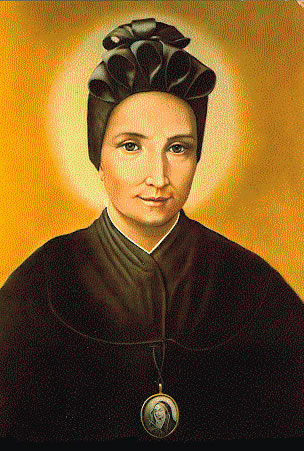April Saints
 Saint Magdalen of Canossa (1774-1835)
Saint Magdalen of Canossa (1774-1835)
Saint Magdalen of Canossa was born Magdalen Gabrielle in Verona, Italy, in 1774. Her father was a naturalist and geologist, her mother a court attendant and lady-in-waiting to Empress Marie Therese’s court in Vienna. When Magdalen was only five, her father died suddenly. Her mother remarried two years later and left Magdalen and her four siblings in the care of their uncle Jerome and the estate servants.
A sickly child, Magdalen grew stronger in both body and spirit as she matured. She dedicated herself to Christ and intended to become a religious. She tried her vocation with the Carmelites, but at the age of 19 had to assume the burdens of the family estate. She proved herself a skilled administrator. By 1803, she was relieved of her estate responsibilities and started her own apostolate, centred on needy children and the dream of providing every child with an education. She opened a school in 1805 and was joined by some young women who eventually formed the founding members of her congregation, the Daughters of Charity.
In 1808, Magdalen overcame her family’s opposition and left Canossa palace once and for all to begin work in the poorest district of Verona. She demonstrated the love of the crucified and risen Christ which burned in her heart by working with her Sisters in five specific areas: charity schools, catechesis, support for women in hospital, training young teachers for rural areas, spiritual exercises for ladies of the nobility with a view to deepening their spiritual lives so that they became involved in charitable works.
Towards the end of her life she was able to start the male branch of her congregation, Sons of Charity, which she had envisaged from the very beginning. Their call was to the Christian formation of boys and men, and she entrusted this Oratory to the Venetian priest, Don Francesco Luzzo, and two laymen.
Magdalen displayed the fire of her charity in her works. She was a gifted mystic, experienced ecstasies and visions, and was a model of charity. In her later years she suffered severe physical problems which she bore heroically. She died on the Friday of Passion Week in 1835, surrounded by her Daughters.
Saint Magdalen, instil in us a love of the poor and needy.
(Source: Internet – various)
Saint Isidore was born into a family of saints. Educated by his older brother, he was taught by means of harshness and abuse which he learned to tolerate. He succeeded his brother as bishop of Seville.
An amazingly learned man, Isidore was sometimes called the ‘Schoolmaster of the Middle Ages’ because the encyclopaedia he wrote was used as a textbook for nine centuries. For this reason, St John Paul II nominated him as patron saint of the internet. He required seminaries to be built in every diocese, wrote a Rule for religious orders and founded schools that taught every branch of learning. Isidore wrote numerous books, including a dictionary, an encyclopaedia, a history of Goths and a history of the world -- beginning with creation! He completed the Mozarabic liturgy, which is still in use in Toledo, Spain.
He continued his austerities even as he approached 80. During the last six months of his life, he increased his charities so much that his house was crowded from morning till night with the poor of the countryside.
Saint Isidore, obtain for us a love of learning.
(Source: Internet – various)
Saint Adalbert of Prague
(c. 956-997)
 The first bishop of Prague to have been born in Bohemia, St. Adalbert was born into a noble family and was sent to Magdeburg to be educated. After the death of his mentor in 981, Adalbert, who had grand visions of missionary work and clerical reform, returned to Prague, and in the following year, he became the second bishop of that city.
The first bishop of Prague to have been born in Bohemia, St. Adalbert was born into a noble family and was sent to Magdeburg to be educated. After the death of his mentor in 981, Adalbert, who had grand visions of missionary work and clerical reform, returned to Prague, and in the following year, he became the second bishop of that city.
Conflict developed between the bishop and the duke of Bohemia, Boleslaus II, and in 990, Adalbert travelled to Rome, where he became a monk. John XV ordered him back to Prague two years later. Gregory V released him from his episcopal duties in 995, after the massacre of Adalbert’s family at Libice, on Boleslaus’ orders. During these five years in Prague, Adalbert founded the abbey of Brevnov.
Boleslaus I, duke of Poland, invited him to evangelise the Prussians of Pomerania. Adalbert was killed on the suspicion of being a Polish spy. Boleslaus I buried Adalbert’s body at Gniezno, Poland, whence it was transported in 1039 to Prague.
Saint Adalbert, give us the spirit of evangelisation.
(Source: www.catholic.org/saints/saint.php?saint_id=858)

 Entries(RSS)
Entries(RSS)